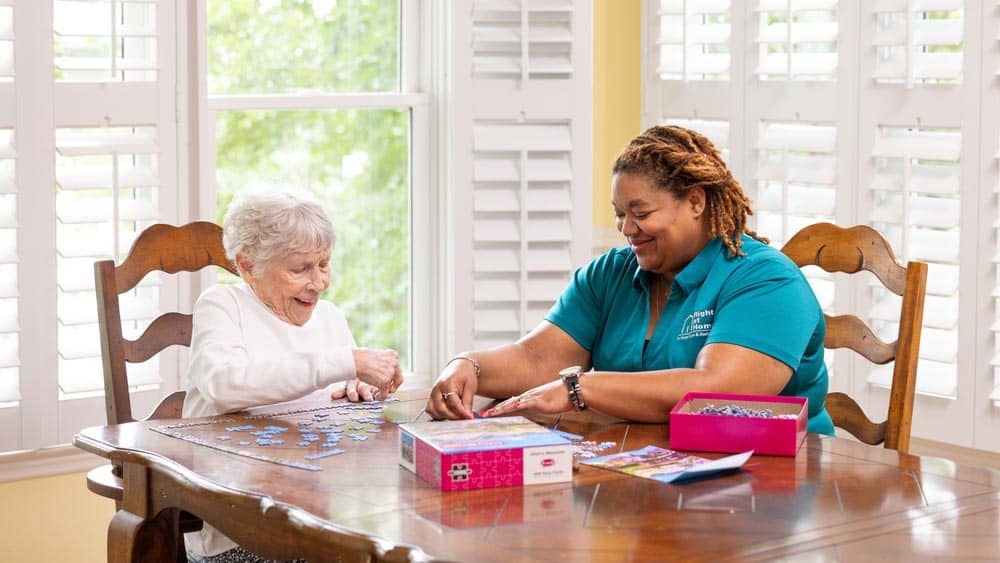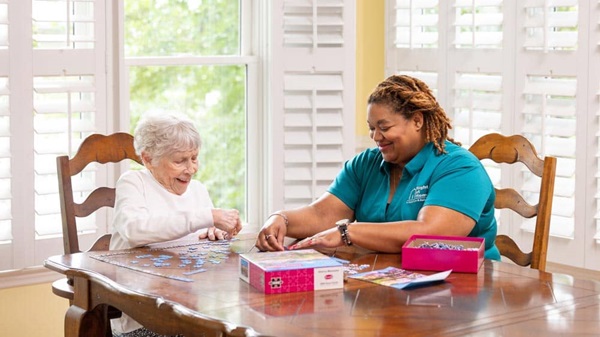

Paying for In-Home Care
Many people choose family caregiving first when a loved one needs care. However, there may come a point at which a person’s caregiving abilities are outpaced by the level of care their loved one needs. An older loved one may need assistance with intimate care tasks like using the restroom or bathing. That’s often when families often turn to professional, in-home care. In-home care is an essential service for many individuals, providing necessary assistance with daily activities and medical needs. However, financing in-home care can be challenging.
Families may not have a good idea of how much in-home caregivers cost, or where to begin the hiring process. Costs vary depending on several factors including location and the amount and type of care provided. But choosing to go with a franchise like Right at Home helps families avoid the complicated tax ramifications of hiring someone directly and having to act as the caregiver’s employer.
There are many different ways that families can fund in-home care, including investments, insurance, family contributions, veterans’ benefits, and government programs like Medicare and Medicaid. It’s important to consider speaking with a financial planner or lawyer when making plans for pay for professional in-home caregiving.
Investments
Investments can be a viable source to finance in-home care. If you have investments in stocks, bonds, mutual funds, or other assets, they can be used to provide funds for care. However, it’s important to consider the tax implications and potential impact on your overall financial portfolio before selling assets.
Insurance options
Long-term care insurance is specifically designed to cover costs of in-home care, nursing homes, and other long-term care services. These policies can vary greatly in terms of coverage, limitations, and costs, so it’s essential to understand the specifics of your policy. This is a funding arrangement that requires some pre-planning. While there’s technically no age limit on long-term care insurance, the premiums are more affordable if the policy is purchased before age 65.
Additionally, life insurance policies may offer an option to cash out or borrow against the policy, providing another potential source of funding.
Family members’ contributions
Family contributions can play a significant role in paying for in-home care. This can be in the form of direct financial assistance or by providing some care themselves, which can reduce the need for paid services. It’s important for families to have open discussions, including the person who needs care, about the financial and time commitments involved in caring for a loved one.
Veterans’ benefits
Veterans and their spouses may be eligible for benefits through the Department of Veterans Affairs (VA). The Aid and Attendance benefit, for example, can help cover in-home care costs for those who qualify. Veterans and their loved ones should contact their local VA office to explore their eligibility for these benefits.
Medicare and Medicaid
Medicare may cover some in-home care services, particularly those that are medically necessary, like nursing care or therapy. However, it does not typically cover long-term in-home care services such as light housekeeping or transportation.
Medicaid, on the other hand, may offer more extensive coverage for in-home care, but eligibility is income-based. Check with your state’s specific Medicaid programs and eligibility criteria.
Other options
Early planning and getting expert advice in your 50’s and 60’s, depending on your family’s situation, is the best way to be prepared for when it is necessary to evaluate your Homecare and/ or Senior Living options.
In my family’s situation back when my mom was in her 60’s she sought the advice of her financial planner, and he recommended purchasing a Long-Term Care Insurance policy back in 2002. Fast forward to 2021 when she had a variety of significant health issues and was diagnosed with Dementia, it was in 2021 that she became eligible for a claim on her policy to use its benefits to pay for care. The claim helped to minimize the cost of care and make it more affordable both at home as well as she transitioned to an Assisted Living Memory Care Community for the rest of her life. We were grateful for advance planning and great advice, so we were able to choose the best option for her as she struggled with declining health. Please contact our office for assistance regarding different ways to pay for In Home Care as we’d welcome the opportunity to see how we can assist your family.
Reverse mortgages: A reverse mortgage allows homeowners to borrow against the equity in their home, providing funds that can be used for in-home care. This option requires careful consideration, as it can affect both the equity you have in your home and your overall estate.
Community resources: Local community organizations, nonprofits, or religious groups may offer assistance or programs to provide or help fund in-home care. State and local programs: Some states and localities offer programs to assist with in-home care costs. These can vary widely, so it’s important to research what’s available in your area. Do an online search for your local area agency on aging and start with them.
Paying for in-home care requires careful planning and consideration of various options. Investments, insurance, family contributions, veterans’ benefits, and government programs like Medicare and Medicaid can all be part of the solution. It’s also wise to consult with a financial advisor or elder care specialist who can provide guidance tailored to your specific situation. Remember, you’re not alone in this journey, and there are resources available to help navigate these challenging decisions.



